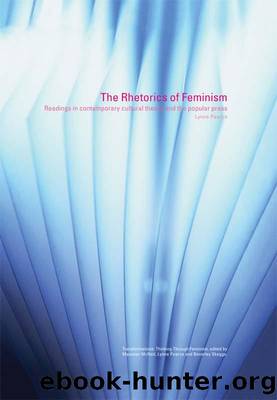The Rhetorics of Feminism by Lynne Pearce

Author:Lynne Pearce [Pearce, Lynne]
Language: eng
Format: epub
Tags: Social Science, Feminism & Feminist Theory, Women's Studies
ISBN: 9780415281829
Google: tcCDqLXipZcC
Publisher: Psychology Press
Published: 2004-01-15T05:46:49+00:00
4 Thinking through the body â or not
This chapter investigates the way in which feminist writers have used conceptual frameworks to generate and develop ideas. In terms of book or thesis production, the text's literal framework â often in the form of a chapter outline â is normally arrived at before the central hypotheses and/or related lines of argument, although it should, ultimately, be intricately bound up with them. It may also, of course, constitute the first step towards a central hypothesis inasmuch as it is the moment the author strives to discover a structure, context or taxonomy for what may be thought of, broadly, as their âsubject of enquiryâ.
The fact, then, that this structure âappearsâ to us as a metaphor, or set of metonymically linked concepts, is not at all surprising. Metaphor, as discussed in the Preface to this section of the book, is the rhetorical mechanism that most conspicuously enables thought-production. While, in classical rhetoric, the âdiscovery of argumentsâ was seen to begin with the formulation of propositions or hypotheses, twentieth-century scholars have recognized that it is the âcollisionâ of two, previously unrelated, concepts or conceptual systems, that more often marks the birth of a new idea: the âbig bangâ account of knowledge, as it were. In metaphorical thinking, as we have already established, one kind of thing is used to understand or experience another that is often quite absurdly âotherâ (e.g. âContemporary theory is a can of wormsâ), while in metonymic thought one entity is used to refer to another that is related to it (e.g. âThe nude has taken over contemporary artâ).1 While Lakoff and Johnson imply that metaphor is the more radical trope conceptually (it works to âexplainâ one concept in terms of another, rather than merely substitute for it) (Lakoff and Johnson 1980: 35), it is clear that both have the potential to generate and organize ideas and are hence invaluable to all those of us struggling to give order, coherence and embodiment to abstract thought.
The extreme usefulness of metaphor in the construction of analytic frameworks was first raised to a conscious level in my own work with the writing of Feminism and the Politics of Reading (Pearce 1997). Struggling to find a means of uniting three of my old essays on reading and reception with my more recent interest in the emotional dimension of the reading process, I hit upon (by sheer chance), Roland Barthes's A Lover's Discourse (1977). This wonderful text provided me not just with a fabu-lously suggestive metaphor â âreading as romanceâ â but a ready-made, exhaustive taxonomy of emotion in all its great subtlety and variety. The effect of the collision of these two systems was extraordinary and served to take me inside the processes of reading in ways that, would have been literally âunthinkableâ before.
Not all books or theses aspire to such conceptual coherence, of course, but in the Humanities and Social Sciences there is normally evidence of an attempt to produce some symmetry, sequence or conceptual mirroring in the list of contents.
Download
This site does not store any files on its server. We only index and link to content provided by other sites. Please contact the content providers to delete copyright contents if any and email us, we'll remove relevant links or contents immediately.
| Anthropology | Archaeology |
| Philosophy | Politics & Government |
| Social Sciences | Sociology |
| Women's Studies |
Born to Run: by Christopher McDougall(7090)
The Leavers by Lisa Ko(6929)
iGen by Jean M. Twenge(5385)
Sapiens by Yuval Noah Harari(5323)
Spare by Prince Harry The Duke of Sussex(5140)
The Kite Runner by Khaled Hosseini(5133)
Machine Learning at Scale with H2O by Gregory Keys | David Whiting(4259)
Bullshit Jobs by David Graeber(4140)
Never by Ken Follett(3884)
Goodbye Paradise(3761)
Livewired by David Eagleman(3729)
Fairy Tale by Stephen King(3307)
A Dictionary of Sociology by Unknown(3044)
Harry Potter 4 - Harry Potter and The Goblet of Fire by J.K.Rowling(3031)
The Social Psychology of Inequality by Unknown(2987)
The Club by A.L. Brooks(2892)
Will by Will Smith(2872)
0041152001443424520 .pdf by Unknown(2815)
People of the Earth: An Introduction to World Prehistory by Dr. Brian Fagan & Nadia Durrani(2711)
